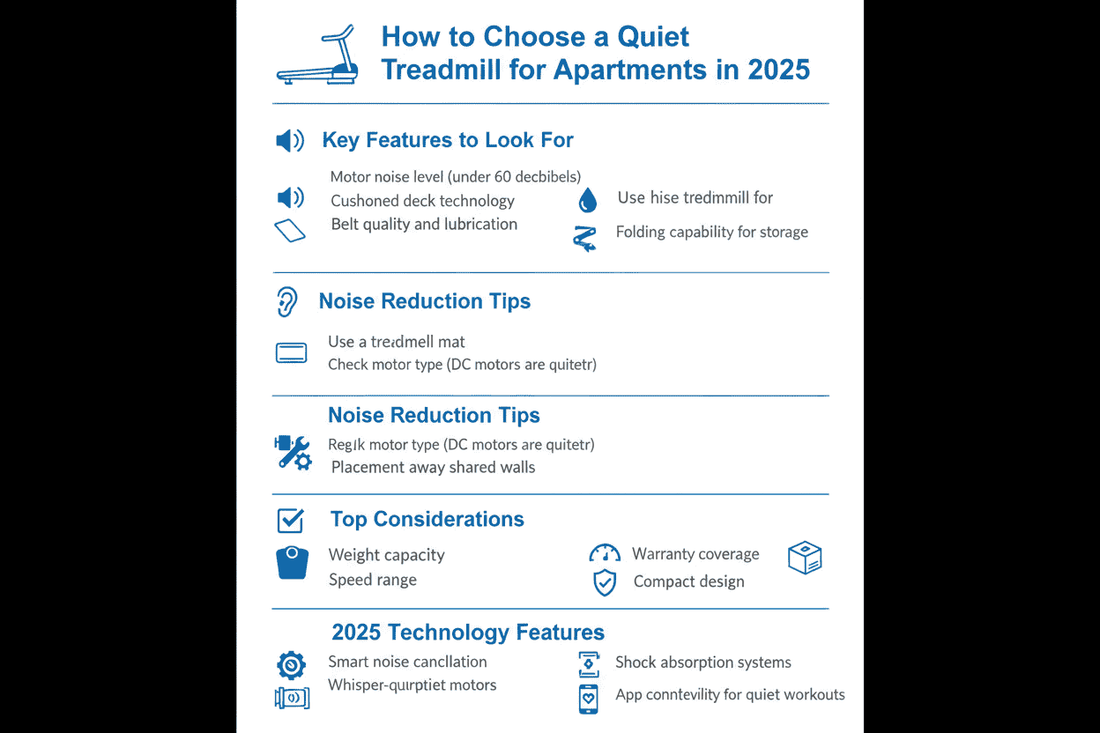
How to Choose a Quiet Treadmill for Apartments in 2025
Share
Q: Can you realistically run or walk on a treadmill in an apartment without disturbing your neighbours?
A: Yes — as long as you choose a model designed for low noise and set it up smartly, you can comfortably work out indoors without becoming the person everyone hears downstairs.
If you're searching for “which treadmill is quiet enough for apartments”, you're in the right place. Apartment living demands extra attention to noise, vibration and space—and your treadmill choice matters. Whether you’re working early mornings while others sleep or running in a shared building, you deserve a machine that keeps your workout peaceful and your neighbours happy.
Who needs a quiet treadmill and why it matters in apartment living
For many of us living in apartments, condo units or flats, the usual home-gym setup has one challenge: your neighbours. Walls, floors and ceilings transmit sound and vibration easily—especially when a treadmill is running. On forums, apartment dwellers frequently report:

- Heavy foot-thuds and belt noise carrying downstairs.
- Motor and incline mechanisms unexpectedly loud during use.
- A treadmill placed on an upper floor causing more noise than expected because vibration travels.
That’s why the question of “which treadmill is quiet enough for apartments” isn’t just academic—it’s central to whether your new workout machine will be a blessing or a burden.
What to look for when picking a low-noise treadmill
1. Decibel (dB) rating & actual noise levels
Look for treadmills measuring around 45-60 dB during use, which is roughly the level of quiet conversation or rainfall. Models louder than ~70 dB may cause disturbance. According to one review of treadmill noise levels, “the quietest treadmills on the market operate at around 40-45 dB… average models produce 65-70 dB… louder models can exceed 80 dB.”
2. Cushioning, deck design & user impact noise
Foot impact often generates more noise than the motor itself. Good cushioning can dampen this “thud” and reduce sound-transmission. For example, one apartment-friendly treadmill guide notes that specialized cushioned decks and impact-absorbing technology “significantly reduce noise transmission to neighbouring apartments.”
3. Frame stability, vibration isolation & flooring
A sturdy frame reduces unwanted squeaks or vibrations. Placing the treadmill on a high-density mat or anti-vibration pads also helps. One how-to article recommends anti-vibration pads or rubber mats under each corner to “alleviate the vibration” passing through floors.
4. Space, placement & usage timing
Choose a machine that fits your footprint and consider placement near walls or in corners where vibration is absorbed. Avoid heavy usage during quiet hours if possible. According to an upstairs-apartment noise guide: “noise levels are louder in an upstairs apartment because the vibrations go down through the structure”.
How to decide: Which treadmill is quiet enough for your apartment?
While no treadmill is truly silent, you can make a smart selection by asking yourself these questions:
- Does the manufacturer list decibel levels (preferably under ~60 dB)?
- Is the treadmill designed with extra cushioning, a strong motor and quiet incline adjustments?
- Will it sit on a stable surface with vibration-reducing accessories (mat, pads)?
- Are you realistic about where it will live (upper floor, shared wall) and when you'll use it (early morning, late night)?
Why the Famistar QuietSeries is a top pick for apartment dwellers
Enter the Famistar QuietSeries treadmill—designed from the ground up for apartment fitness. With a motor purposely tuned for sub-55 dB operation, a high-density cushioned deck, and a folding profile that fits compact spaces, it addresses the “which treadmill is quiet enough for apartments” question head-on.
Key features you’ll appreciate:
- Low noise motor and incline mechanism engineered to reduce whine and hum.
- Shock-absorbing deck to reduce foot impact noise and vibration travel.
- Compact foldable design, ideal for apartments or multi-use rooms.
- Supports a wide user-weight range while maintaining quiet stability.
If you’ve been hesitant to bring a treadmill into shared-living space, Famistar’s QuietSeries gives you confidence that your workout won’t become a neighbour-disturbance.
Tips to make your treadmill even quieter in your apartment
Even the best treadmill can benefit from setup tweaks:
- Use a thick rubber mat or interlocking floor pads under the machine.
- Keep the treadmill level—uneven flooring creates extra vibration.
- Avoid running at super-high speeds late at night—foot impact noise travels.
- Check and tighten bolts periodically—loose parts amplify sound.
Frequently Asked Questions
How loud should a treadmill be for apartment use?
Ideally, aim for a treadmill that operates around 45-60 dB under typical use. This level is considered quiet conversation or rainfall—manageable in shared spaces.
Can a treadmill disturb downstairs neighbours?
Yes—especially if the machine causes floor vibration. Even 50 dB motor noise plus foot impact can translate into much higher perceived noise below. Proper mats, placement and quieter models reduce this risk.
Do under-desk treadmills count as quiet options?
They can be quieter since they’re low-speed walking machines rather than running treadmills. But even then, look for decibel ratings under 60 dB and good cushioning if used around colleagues or family.
Is there a treadmill noise rating standard?
No formal industry-wide standard exists yet. Many reviews report decibel measurements from independent testing. Be sceptical of vague claims like “whisper-quiet” without numbers.
Final verdict & next steps
So — “which treadmill is quiet enough for apartments?” — the answer is: one that combines low noise motor, good cushioning, stable frame, and smart setup. With the right machine and the right placement, you can stay active, crush your goals and still keep the peace in your building.
If you’re ready to move forward, check the specs, measure your space, get an anti-vibration mat and you’re halfway there. You don’t have to compromise your fitness because of noise concerns—make your treadmill work *with* your living environment.

